Earth farthest from the sun, Mercury closest
Earth is farthest from the sun on the 4th. It’s 152 million kilometers or 94.5 million miles away. In six months, the sun’s disk will appear 3.6% bigger. That’s not something the human eye can detect—and don’t try without eye protection! Only in photographs or with measurements taken by scientific instruments can the difference be seen. The earth orbits the sun in a figure that’s close enough to a circle to keep the sun’s visual width very close to 0.5° all year.
Venus orbits in a more nearly perfect circle. If you could see the sun in spite of all the clouds on the planet, the sun’s disk would barely change size from 43’54” at aphelion (farthest from the sun) to 44’30” at perihelion (closest). The closer measurement is just 1.3% bigger. Of course, that’s nearly 50% bigger than it would look from Earth on any day. Venus will not go through aphelion or perihelion this month.
Mercury’s orbit is much more eccentric (how much more elliptical than circuluar). At aphelion, the sun appears to be 1°8’31” wide. It’s 1°43’58” at perihelion. The change is 51.7%. The sun’s disk goes from looking a little more than twice its size from Earth to almost three-and-a-half times. Mercury will be at perihelion on the 10th. It will be 46.1 million kilometers or 26.8 million miles from the sun.
Moon’s circumstances
The month starts with a thin crescent moon rising in the evening. It passes through the stars of Leo in the first few evenings of the month, passing in front of Al Jabhah (Eta Leonis) on the 3rd UT for sky watchers in the Gulf of Carpentaria and Cape York areas of Australia, the island of New Guinea, and the Bismarck Sea.
The moon’s approaching first quarter as it enters Virgo. Viewers in northeast Africa and on the Arabian Peninsula on the 6th can see it pass in front of Porrima. The moon will be a little south of the equator, having crossed it earlier that day. First quarter is on the 7th.
A gibbous moon approaching full phase occults Dschubba in Scorpius on the 10th UT. The view is from far east Asia. Sky watchers in Taiwan, the Koreas, and Japan get the best of it.
Southern lunistice is on the 12th at 26.9° and the moon is full on the 13th. It will be a close full moon for southern hemisphere observers, because perigee is also on the 13th with a distance of 357,200 kilometers or 222,000 miles.
And as the waning moon moves northward, it passes in front of Nunki on the 13th UT for those who can watch from a wide path that begins in the southern Pacific Ocean, crosses the southern tip of South America, and ends on the South Atlantic. Most of the visibility is from ships at sea. Land based observing sites include southern Chile, southern Argentina, and Tristan da Cunha.
In the second half of the month, the moon passes several planets, starting with Saturn on the 15th UT. It passes Jupiter on the 19th. On the same day, it crosses the equator going northward. Then it reaches last quarter on the 20th. Mars is at southern solstice on the 21st as the moon passes by it in our morning sky. The moon is at northern lunistice on the 26th at 26.9° and passes Venus in our sky the same day. New moon is on the 28th.



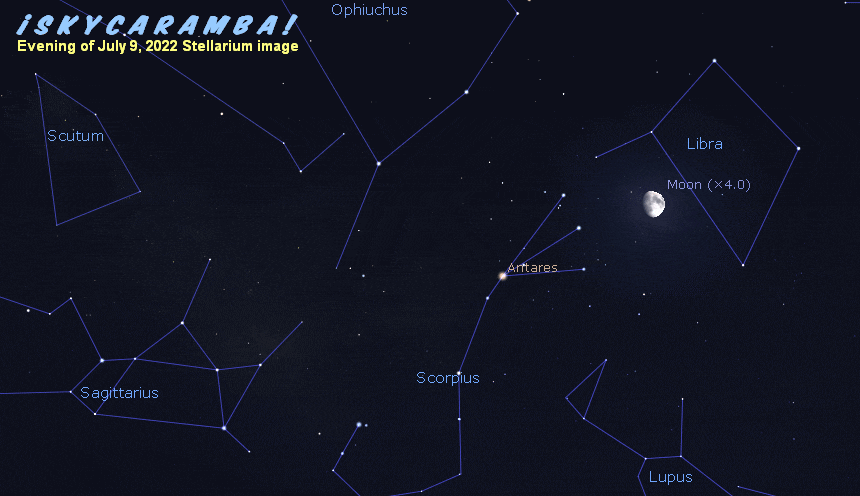
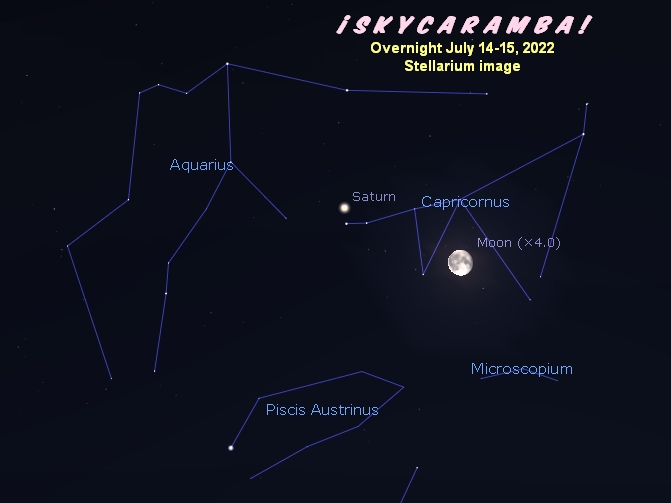
Planets’ visibility
Saturn rises by mid evening. It’s retrograde in Capricornus passing north of Deneb Algedi and approaching Nashira. It makes a nice triangle with them. The ringed planet is a mid-evening riser by the end of the month. Northern hemisphere observers see it not long after sunset by then.
Jupiter rises around midnight in Pisces. Its motion is direct (eastward) for most of the month and rises earlier each night. By about the 20th, the planet appears stationary. That is to say it’s holding nearly still among the stars behind it. But because those stars continue rising earlier every night, so does Jupiter. It’s a late evening riser by the end of July. Jupiter’s retrograde motion begins on the 29th, but it will continue to appear stationary until mid-August.
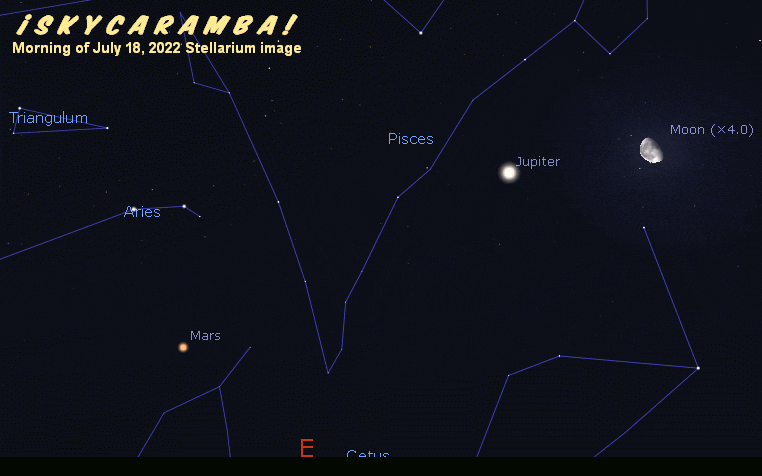
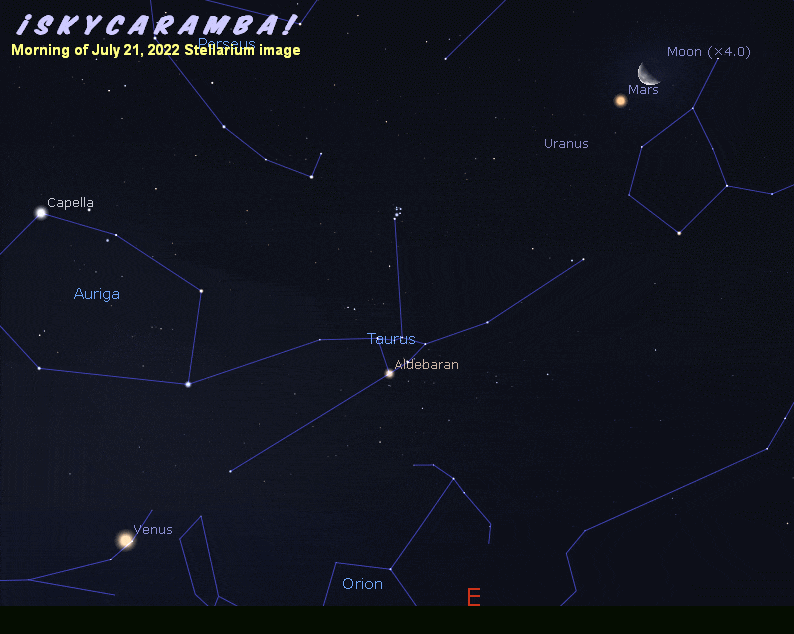
Mars is deeper into Pisces when July begins. Its motion is direct all month as it passes over the head of Cetus the sea monster. Mars is heading to a close meeting with Uranus in early August. You’ll need magnification to see the faint blue dot of Uranus. The color contrast with the red planet will look good. Mars will rise around midnight by the end of July.
The Pleiades rise in the morning before dawn. Below them is bright Venus coming off the Hyades V leg opposite orange Aldebaran on the first morning of July. The planet quickly moves east of the asterism and is close to the dim star Tianguan on the 13th. It passes throught the feet of Gemini beginning on the 18th. By month’s end, the planet is at the twins’ waistlines.
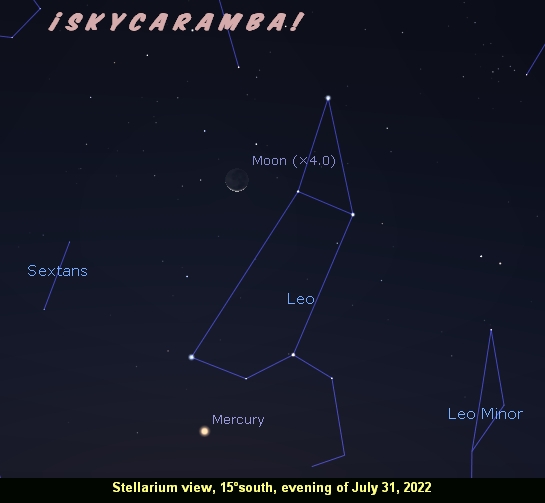
Mercury is in the morning sky when the month starts. If you can find it, it will be below right of Elnath in Auriga. The leg of the Hyades V with Aldebaran will almost point the way to the planet. But the planet’s moving fast. It’s heading toward superior conjunction on the 16th. Observers about 4° south of the equator will get the best view as the messenger planet sinks into the sunrise. An evening object the rest of the month, the first views will likely be from about 14° south. The planet will appear to be almost in the sickle of Leo as it and the constellation set.
Pluto is at opposition on the 20th. Given the planet’s magnitude of 13.65, you will need a big telescope, a very dark sky, and knowledge of its precise location to see it.
Neptune remains near the Pisces fish head that’s closest to Aquarius. The moon passes by on the 18th.
Meteor shower
The Southern Delta Aquariids meteor shower peaks on July 30th. With the moon just past new, there’ll be no moonlight to spoil the view when the radiant point rises about mid-evening. Find a dark sky and maybe you’ll see up to 20 meteors per hour. This shower has a broad enough peak to offer a show for several nights, so start watching a few nights before the peak and keep watching for a few nights after.
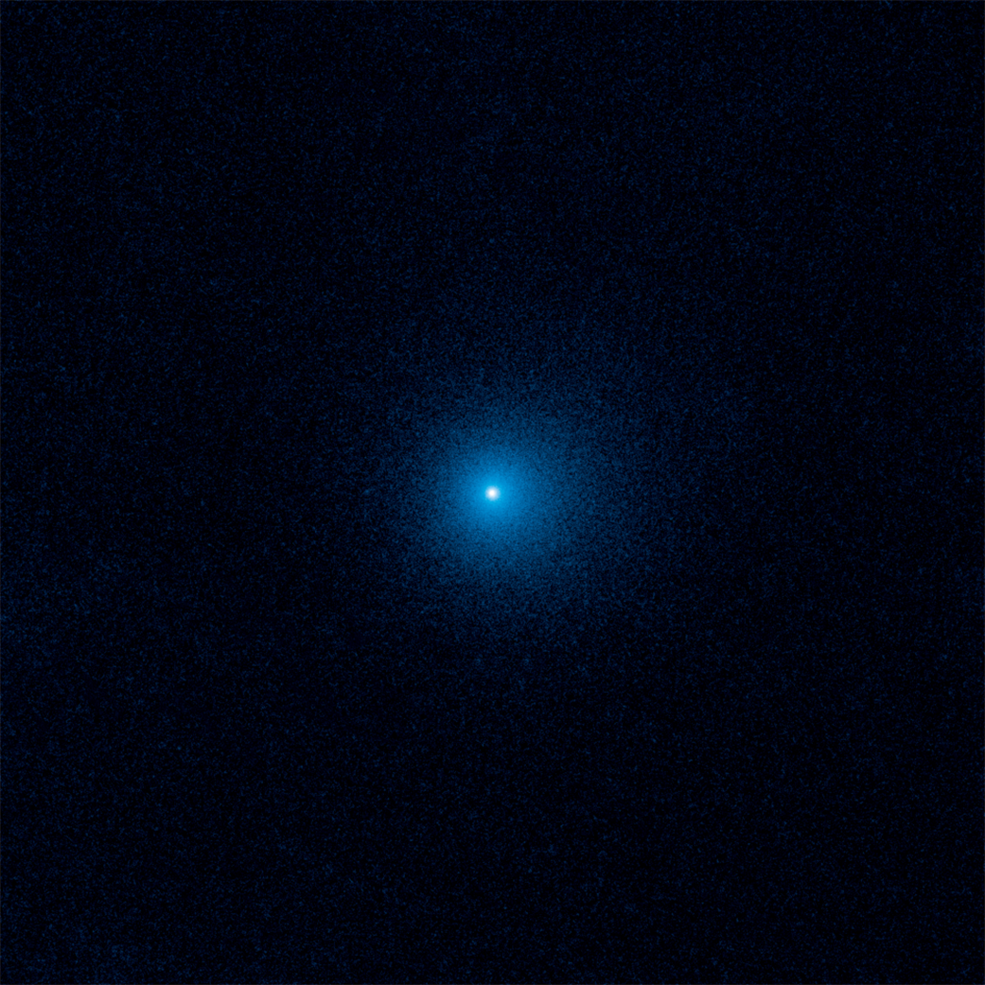
Comet
A comet discovered in 2017 will be closest to Earth this month. The formal name is PANSTARRS C/2017 K2. We can call it K2 for short. It’ll be about 1.8 astronomical units from Earth on the 14th. As of late June, it’s slightly brighter than ninth magnitude and reach about magntitude eight at its peak. That will make it visible in small and medium size telescopes in dark enough skies. K2 won’t be closest to the sun until December 19th. But it’s been a rather active comet already. At the time of its discovery, it was the farthest active comet ever known.
K2 is thought to be a truly new comet on its first run to the planetary part of the solar system. It may have started its trip from the Oort Cloud millions of years ago. After this first time through, it may return in about 18,000 years.
